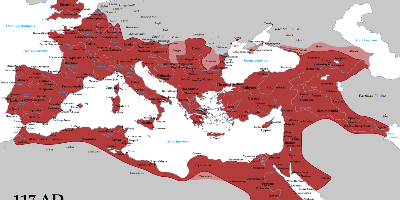1 gen 106 anni - Province of Dacia Organized
Descrizione:
Roman Dacia was a province of the Roman Empire from 106 to 271–275 AD. Its territory consisted of Transylvania, Oltenia (regions of modern Romania) and Banat (split between Romania, Serbia and Hungary). It was from the very beginning organized as an imperial province, fitting a border area, and remained so throughout the Roman occupation. Historians' estimates of the population of Roman Dacia range from 650,000 to 1,200,000.The conquest of Dacia was completed by Emperor Trajan (98–117) after two major campaigns against Decebalus' Dacian Kingdom. The Romans did not occupy the entirety of it, as the greater part of Moldavia, together with Maramureș and Crișana, were ruled by Free Dacians even after the Roman conquest. In 119, the Roman province was divided into two departments: Dacia Superior ("Upper Dacia") and Dacia Inferior ("Lower Dacia"; later named Dacia Malvensis). In 124 (or around 158), Dacia Superior was divided into two provinces: Dacia Apulensis and Dacia Porolissensis. During the Marcomannic Wars, the military and judicial administration was unified under the command of one governor, with other two senators (the legati legionis) as his subordinates; the province was called tres Daciae ("Three Dacias") or simply, Dacia.
The Roman authorities undertook a massive and organized colonization of Dacia; new mines were opened and ore extraction intensified, while agriculture, stock breeding, and commerce flourished in the province. Dacia began to supply grain not only to the military personnel stationed in the province but also to the rest of the Balkans. It became an urban province, with about ten cities known, eight of which held the highest rank of colonia, though the number of cities was fewer than in the region's other provinces. All of them developed from old military camps. Ulpia Traiana Sarmizegetusa, the seat of the imperial procurator (finance officer) for all the three subdivisions, was the financial, religious, and legislative center of the province. Apulum, where the military governor of the three subdivisions had his headquarters, was not simply the greatest city within the province, but one of the biggest across the whole Danubian frontier.
There were military and political threats from the beginning of Roman Dacia's existence. Free Dacians who bordered the province were the first adversaries, who, after allying themselves with the Sarmatians, hammered the province during the reign of Marcus Aurelius. Following a calmer period covering the reigns of Commodus through to Caracalla (180–217 AD), the province was once again beset by invaders; the Carpi, a Dacian tribe in league with the newly arrived Goths, who in time became a serious difficulty for the empire. Finding it increasingly difficult to retain Dacia, the emperors were forced to withdraw from it by the 270s, making it the first of Rome's long-term possessions to be abandoned.[2] Dacia was devastated by the Germanic tribes (Goths, Taifali, and Bastarnae) together with the Carpi in 248–250, by the Carpi and Goths in 258 and 263, and by the Goths and Heruli in 267 and 269.[3][4] Ancient sources implied that Dacia was virtually lost during the reign of Gallienus (253–268), but they also report that it was Aurelian (270–275) who relinquished Dacia Traiana. He evacuated his troops and civilian administration from Dacia, and founded Dacia Aureliana with its capital at Serdica in Lower Moesia.
The fate of the Romanized population of the former province of Dacia Traiana has become subject of spirited controversy. One theory holds that the Latin language spoken in ancient Dacia, where Romania was to be formed in the future, gradually turned into Romanian; in parallel, a new people—the Romanians—were formed from the Daco-Romans (the Romanized population of Dacia Traiana). The opposing theory argues that the Romanians descended from the Romanized population of the Roman provinces of the Balkan Peninsula.
Aggiunto al nastro di tempo:
Data:
1 gen 106 anni
Adesso
~ 1921 years ago
